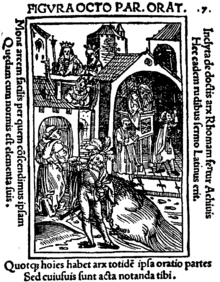Matthias Ringmann

Matthias Ringmann (also known as Philesius Vogesigena) (1482–1511) was a German cartographer and humanist poet. He is credited with naming America on the map of his friend Martin Waldseemüller in Cosmographiae Introductio.
Life
Born in Eichhoffen (Alsace) in 1482 (although this date is questioned), he also used the name Philesius Vogesigena. He became a schoolmaster and is often described as a poet.
Some time around 1503 Ringmann visited Italy, where he first learned about explorations of the recently discovered western lands later known as the New World and later named the Americas. He mistakenly came to believe that Amerigo Vespucci had discovered the New World.
Upon his return to Germany, Ringmann moved to Saint-Dié-des-Vosges in Lorraine with his friend Martin Waldseemüller, a cartographer with whom he was working on a new Latin edition of Ptolemy's treatise on geography. Waldseemüller drew the maps while Ringmann edited the translation and wrote a preface. Ringmann is also the best candidate for the author of the introduction to Waldseemüller's great map and globe of the world although many historians attribute the work to Waldseemüller himself. It seems probable that Walter Ludd, the head of the Gymnasium Vosagense paid Ringmann and Waldseemüller to do this work for publication at the Gymnasium's printing press at St. Dié.
Ringmann may have read the French edition of Vespucci's letters (Quatre Navigations d' Americ Vespuce). Whether this book or conversations in Italy were the source of Ringmann's misunderstanding of the accepted discoverer of the New World, he wrote in his introduction:
"There is a fourth quarter of the world which Amerigo Vespucci has discovered and which for this reason we can call 'America' or the land of Americus [the Latin version of the Italian name Amerigo]. […] We do not see why the name of the man of genius, Amerigo, who has discovered them, should not be given to these lands, as Europe and Asia have adopted the names of women."
When the book was published as Cosmographiae Introductio on April 25, 1507 it was the first time that the word 'AMERICA' appeared in print. Waldseemüller corrected the error in a later edition and named South America "Terra Nova", but the name America was already established.
Ringmann corrected the texts of the Latin editions of Ptolemy's geography published previously at Rome and Ulm, using a Greek manuscript borrowed from Italy (Codex Vaticanum Graecorum 191) while Waldseemüller edited the Ptolemaic maps and added twenty new ones. The result has been described as "the first modern atlas of the world".
In 1508 Ringmann made the first translation of Julius Caesar's Commentaries into German with supplemental lives by Suetonius, Plutarch, and others. One year later he published a card game Grammatica Figurata to make the grammatical rules of Donatus' Ars Minor more appealing to children. He died in 1511 in Sélestat.
Grammatica Figurata

The Grammatica Figurata of Mathias Ringmann was first printed in 1509. This work was an attempt to enliven Donatus' Ars Minor by printing up illustrated card sets for each grammatical rule. Apparently the children would have a card set. The rules are not explained at length, but a few hints are scattered here and there in the work. The final section on "Exclamations" has a sentence on how to figure out which student has won. Each card represented a part of speech, a gender, a case, or a tense, etc. Depending upon the teacher's questions a student would play the appropriate card or cards. It is wacky and interesting even if it is of questionable pedagogical value. Long believed to be lost, one copy of Grammatica figurata was found and reprinted in 1905.[1] Of particular interest are Ringmann's digressions on assorted subjects, from the prevalence of gambling among the German priesthood to the reasons behind his refusal to illustrate full-frontal nudity.
Notes
- ↑ It was scanned and put on the internet by Ken Mayer (see: ).
References
- Lester, Toby (December 2009). "Putting America on the Map". Smithsonian 40 (9).
- Lester, Toby (2010). The Fourth Part of the World: An Astonishing Epic of Global Discovery, Imperial Ambition, and the Birth of America. New York: Free Press. ISBN 1-4165-3534-9.
Bibliography
- Waldseemüller, Martin, & Matthias Ringmann. Cosmographiae Introductio, (St. Die: 1507)
- Caesar, Julius. Ringmann Matthias (tr.) Julius der erst römisch Keiser von seinem Leben und Krieg, erstmals uss dem Latein in Tütsch gebracht vnd mit andrer Ordnung der Capittel und uil zusetz nüw getruckt. (Strassburg: Durch Joannem Grüninger, 1508).
- Ringmann, Matthias. Grammatica Figurata, (St. Die: 1509)
- Waldseemüller, Martin, & Matthias Ringmann (ed.). Clavdii Ptolemei Viri Alexandrini ... Geographie Opus Novissima Traductione E Grecorum Archetypis Castigatissime Pressum. (Strassburg: Johann Schott, 1520)
External links
| Wikimedia Commons has media related to Cosmographia. |
| Wikimedia Commons has media related to Matthias Ringmann. |
- Plaque in Freiburg commemorating Ringmann and Waldseemüller
- Wieser, Franz, Ritter von (ed.). Grammatica figurata des Mathias Ringmann (Philesius Vogesigena) in Faksimiledruck, (Strassburg: Heitz, 1905)
- Mayer, Ken. Matthias Ringmann: Grammatica Figurata, <http://trionfi.com/0/c/09/t.html> Retrieved April 4, 2005
- Fischer, J. 'Martin Waldseemüller', Catholic Encyclopedia, (1912)
- Press release about a new edition of the Waldseemüller world map
|